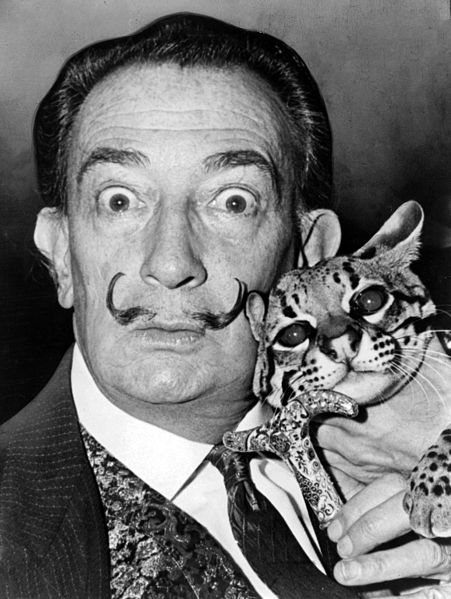For Salvador Dali, everything in life could be considered as a work of art, and this certainly included his mustache. It made him instantly recognizable and gave him the flamboyant look he was known for.

Salvador Dali in 1965; photo via Wikipedia
Check out the life and work of the art world’s famous mustachioed man.
The mustache
Dali’s mustache was a slender type, waxed with the tips curled upward. He once said that this style of mustache was influenced by the Spanish painter Diego Velázquez. It was voted most the “best-known moustache of all time” by Britain’s Daily Telegraph, which polled 14,144 British men in honor of Movember in November 2010.
In a television game in 1954, he was asked if his mustache was a joke. He replied, “It’s the most serious part of my personality. It’s a very simple Hungarian moustache. Mr. Marcel Proust used the same kind of pomade for this moustache.” You can see the original video (and the mustache) here.
Dali’s early life
Salvador Dali was born in Figueres, Spain, in 1904. He was named after his brother, who was 9 months older and died from gastroenteritis before he was born. The death of the brother he never met made a huge impact on his life, and perhaps triggered the beginning of an identity crisis. As a child, when his parents talked about Salvador, he would often find himself confused as to whether they were talking about him or his deceased brother. In one account of his childhood, he recalls an early memory of visiting his brother’s grave and his parents telling him he was his brother’s reincarnation.
Early in life, Dali did show some abilities in drawing and painting, and was encouraged to pursue his talents by his mother, who passed away from cancer when he was just 16-years-old. He went on to study at the Royal Academy of Fine Arts of San Fernando in Madrid, where he was formally trained in classical painting and did study the techniques of the old masters, which later influenced his unique and detailed style of dreamlike pictures. He was expelled from the academy before taking his final exam, as he did consider himself more qualified than the teachers that were going to examine him.
In 1926, Dali traveled to Paris, where he met Picasso, Magritte and Miro. Miro believed in Dali’s talent and introduced him to his surrealist friends and Parisian art dealers. He joined the surrealist movement in 1929.
Paris is also where Dali met his wife, Gala, who would become his lifelong companion, muse and business manager.
Dali, the surrealist painter
Surrealism is an cultural movement that explores the subconscious in dreamlike pictures and free associations, aiming at freeing the imagination of the control exercised by reason, mainly known in visual artworks and writing, it was also applied to sculpture, filmography, theater and other art forms.
This movement was strongly influenced by Freud’s The Interpretation of Dreams (1900), although Freud himself wouldn’t categorize the work of the surrealists as being done in a subconscious state.
Salavador Dali, one of the most famous of the surrealist painters along with Rene Magritte, was excellent at marketing himself and certainly mastered the art of creating controversy and being the center of attention with his eccentric manners.

Salvador Dali and Man Ray, 1934; photo via Wikipedia
Dali was very prolific and created more than 1500 paintings in his life. Although he is mostly known for his paintings, he was also a very versatile artist and did work in many different areas, including sculpture, jewelry, fashion design, theater, movies (he worked with Alfred Hitchcock and created storyboards for a short movie in collaboration with Walt Disney), furniture (he designed a famous sofa shaped in the form of actress Mae West’s lips). And he did lots of cooperative works with other artists. His most famous painting is The Persistence of Memory, which features the now-iconic melting watches.
Salvador Dali died in 1989 at the age of 84 in Figueres of heart failure, only two years after his beloved wife Gala passed away.

Share tips, start a discussion or ask one of our experts or other students a question.
No Responses to “The Life and Mustache of Salvador Dali”